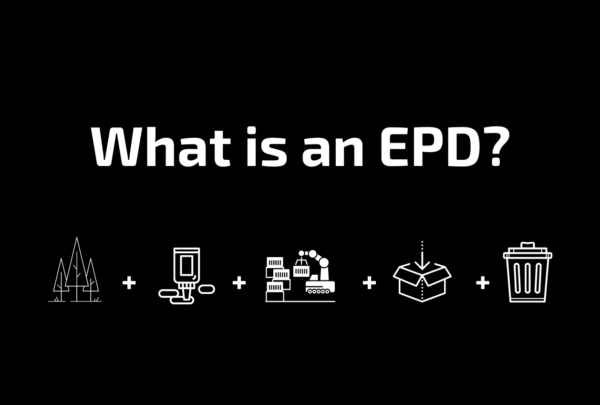Have you ever wondered how to measure the environmental impact of a building? In this blog we will be talking about all things EPD’s and why you should consider them when designing your next project.
An environmental product declaration (EPD) is an independent framework commonly used for construction-based products to help consumers understand a manufacturers environmental impact. This rating system takes into account data regarding products and their lifecycle in order to measure its environmental footprint during each stage of the production and disposal process. The goal of this framework is to support the consumer in their decision making when choosing building materials.
An EPD measures a product’s impact on the environment throughout its entire lifecycle – from cradle to grave. This is made up of several environmental impact indicators such as:
An EPD quantifies this data to create numeric values for each product and its lifecycle stages, simplifying the consumers comparison and decision-making process.
Below is a simple diagram illustrating the lifecycle of hardwood glulam. The numbers labelled in green are referred to as credits which are impacts avoided in the next product system, while numbers labelled in grey are considered environmental impacts. These figures derived from the Environmental Product Declaration for Hardwood Glue Laminated Timber and are measured as the amount of CO2 per m3 of hardwood glue-laminated timber.

From this diagram we can see that in its early stages, hardwood glulam is given a credit – this is due to the carbon stored in its wood fibres that is not released until timber decomposes. As the timber eventually goes through the product lifecycle, environmental impacts are added to this figure.
This diagram is based off the Environmental Product Declaration for Hardwood Glue Laminated Timber. See link for full details – https://epd-australasia.com/epd/glued-laminated-timber-glulam/
From the glulam hardwood diagram above, we can see that even after the entire production process – this includes forestry, transportation, drying, processing and packing – timber is a sustainable material to use.
Carbon Storage – When compared to its counterparts, timber has a strong advantage due to its ability to store and lock carbon throughout its lifecycle. Growing trees absorb carbon dioxide from the atmosphere, emit oxygen and act as long-term carbon storage. This carbon remains locked in the timber until it burns or rots, therefore the timber that we use for building and construction can store carbon for life.
Embodied Energy – Embodied energy refers to the energy used when making the materials required for the construction of a building. Choosing materials such as timber and avoiding high fossil fuel alternatives can drastically change the amount of embodied carbon that is produced from a building, lowering the overall environmental footprint of the build.
The Timber Industry’s Circular Economy – Instead of making, using and disposing of materials, we can choose products from circular economies – when manufacturers reuse and recycle as much as they possibly can, creating a circular loop. The Australian Timber Industry is known to have one of the best circular economies as laws ensure that forested trees are replaced. This means that even when timber decomposes or is burnt, those emissions are then re-captured in the growing process, ultimately closing the loop. The timber lifecycle is also recognised for its relatively low carbon footprint and minimal amounts of waste. For example, at ASH, 100% of our timber is used, including our woodchips and sawdust which is used as green energy to power the site and animal bedding.
Overall, EPD’s are handy tools you can use to help minimise your environmental footprint during the design stages of your project. We hope this blog can help you make more informed decisions when choosing sustainable materials for your next project. To read the hardwood and glulam EPD’s, login to Wood Solutions here.
"*" indicates required fields
